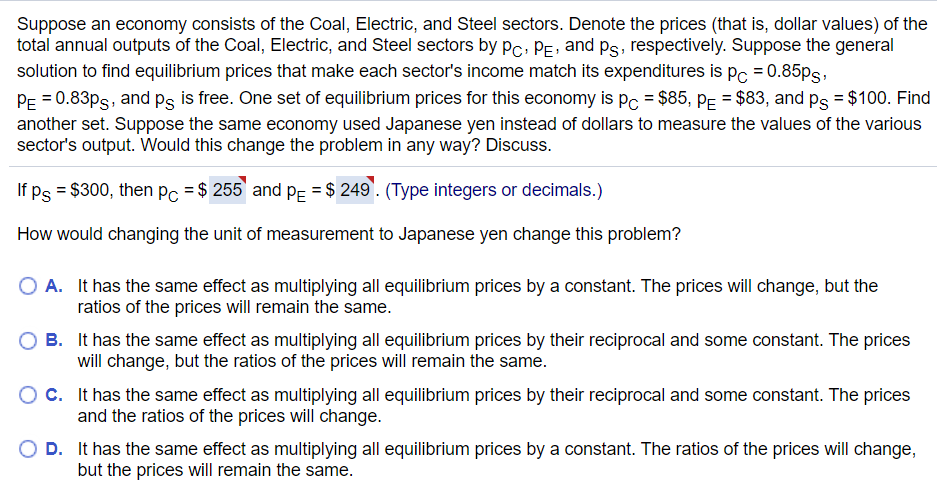Suppose an economy consists of the Coal, Electric, and Steel sectors. Denote the prices (that is, dollar values) of the total annual outputs of the Coal, Electric, and Steel sectors by PC, PE, and ps, respectively. Suppose the general solution to find equilibrium prices that make each sector's income match its expenditures is pc = 0.85ps, PE=0.83ps, and på is free. One set of equilibrium prices for this economy is pc = $85, P = $83, and på = $100. Find another set. Suppose the same economy used Japanese yen instead of dollars to measure the values of the various sector's output. Would this change the problem in any way? Discuss. If Ps = $300, then pc = $ 255 and PE = $249. (Type integers or decimals.) How would changing the unit of measurement to Japanese yen change this problem? O A. It has the same effect as multiplying all equilibrium prices by a constant. The prices will change, but the ratios of the prices will remain the same. B. It has the same effect as multiplying all equilibrium prices by their reciprocal and some constant. The prices will change, but the ratios of the prices will remain the same. OC. It has the same effect as multiplying all equilibrium prices by their reciprocal and some constant. The prices and the ratios of the prices will change. OD. It has the same effect as multiplying all equilibrium prices by a constant. The ratios of the prices will change, but the prices will remain the same.
Suppose an economy consists of the Coal, Electric, and Steel sectors. Denote the prices (that is, dollar values) of the total annual outputs of the Coal, Electric, and Steel sectors by PC, PE, and ps, respectively. Suppose the general solution to find equilibrium prices that make each sector's income match its expenditures is pc = 0.85ps, PE=0.83ps, and på is free. One set of equilibrium prices for this economy is pc = $85, P = $83, and på = $100. Find another set. Suppose the same economy used Japanese yen instead of dollars to measure the values of the various sector's output. Would this change the problem in any way? Discuss. If Ps = $300, then pc = $ 255 and PE = $249. (Type integers or decimals.) How would changing the unit of measurement to Japanese yen change this problem? O A. It has the same effect as multiplying all equilibrium prices by a constant. The prices will change, but the ratios of the prices will remain the same. B. It has the same effect as multiplying all equilibrium prices by their reciprocal and some constant. The prices will change, but the ratios of the prices will remain the same. OC. It has the same effect as multiplying all equilibrium prices by their reciprocal and some constant. The prices and the ratios of the prices will change. OD. It has the same effect as multiplying all equilibrium prices by a constant. The ratios of the prices will change, but the prices will remain the same.
Chapter1: Making Economics Decisions
Section: Chapter Questions
Problem 1QTC
Related questions
Question
Sub : Economics
Pls answer very fast.I ll upvote correct answer. Thank You

Transcribed Image Text:Suppose an economy consists of the Coal, Electric, and Steel sectors. Denote the prices (that is, dollar values) of the
total annual outputs of the Coal, Electric, and Steel sectors by PC, PE, and Ps, respectively. Suppose the general
solution to find equilibrium prices that make each sector's income match its expenditures is pc = 0.85ps,
PE=0.83ps, and på is free. One set of equilibrium prices for this economy is pc = $85, P = $83, and p = $100. Find
another set. Suppose the same economy used Japanese yen instead of dollars to measure the values of the various
sector's output. Would this change the problem in any way? Discuss.
If ps = $300, then pc = $ 255 and P₁ = $ 249. (Type integers or decimals.)
How would changing the unit of measurement to Japanese yen change this problem?
O A. It has the same effect as multiplying all equilibrium prices by a constant. The prices will change, but the
ratios of the prices will remain the same.
B.
It has the same effect as multiplying all equilibrium prices by their reciprocal and some constant. The prices
will change, but the ratios of the prices will remain the same.
O C.
It has the same effect as multiplying all equilibrium prices by their reciprocal and some constant. The prices
and the ratios of the prices will change.
O D.
It has the same effect as multiplying all equilibrium prices by a constant. The ratios of the prices will change,
but the prices will remain the same.
Expert Solution
This question has been solved!
Explore an expertly crafted, step-by-step solution for a thorough understanding of key concepts.
Step by step
Solved in 3 steps

Knowledge Booster
Learn more about
Need a deep-dive on the concept behind this application? Look no further. Learn more about this topic, economics and related others by exploring similar questions and additional content below.Recommended textbooks for you


Principles of Economics (12th Edition)
Economics
ISBN:
9780134078779
Author:
Karl E. Case, Ray C. Fair, Sharon E. Oster
Publisher:
PEARSON

Engineering Economy (17th Edition)
Economics
ISBN:
9780134870069
Author:
William G. Sullivan, Elin M. Wicks, C. Patrick Koelling
Publisher:
PEARSON


Principles of Economics (12th Edition)
Economics
ISBN:
9780134078779
Author:
Karl E. Case, Ray C. Fair, Sharon E. Oster
Publisher:
PEARSON

Engineering Economy (17th Edition)
Economics
ISBN:
9780134870069
Author:
William G. Sullivan, Elin M. Wicks, C. Patrick Koelling
Publisher:
PEARSON

Principles of Economics (MindTap Course List)
Economics
ISBN:
9781305585126
Author:
N. Gregory Mankiw
Publisher:
Cengage Learning

Managerial Economics: A Problem Solving Approach
Economics
ISBN:
9781337106665
Author:
Luke M. Froeb, Brian T. McCann, Michael R. Ward, Mike Shor
Publisher:
Cengage Learning

Managerial Economics & Business Strategy (Mcgraw-…
Economics
ISBN:
9781259290619
Author:
Michael Baye, Jeff Prince
Publisher:
McGraw-Hill Education